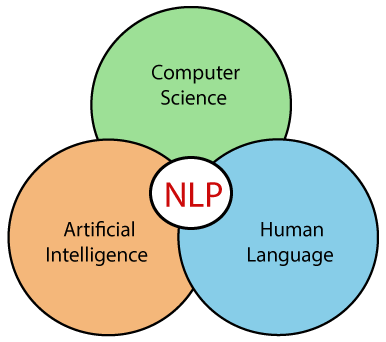What is NLP?
NLP stands for Natural Language Processing, which is a part of Computer Science, Human language, and Artificial Intelligence. It is the technology that is used by machines to understand, analyse, manipulate, and interpret human’s languages. It helps developers to organize knowledge for performing tasks such as translation, automatic summarization, Named Entity Recognition (NER), speech recognition, relationship extraction, and topic segmentation.

Components of NLP
There are the following two components of NLP –
- Natural Language Understanding (NLU)
Natural Language Understanding (NLU) helps the machine to understand and analyse human language by extracting the metadata from content such as concepts, entities, keywords, emotion, relations, and semantic roles.
NLU mainly used in Business applications to understand the customer’s problem in both spoken and written language.
NLU involves the following tasks –- It is used to map the given input into useful representation.
- It is used to analyze different aspects of the language.
- Natural Language Generation (NLG)
Natural Language Generation (NLG) acts as a translator that converts the computerized data into natural language representation. It mainly involves Text planning, Sentence planning, and Text Realization.
Difference between NLU and NLGNLU NLG NLU is the process of reading and interpreting language. NLG is the process of writing or generating language. It produces non-linguistic outputs from natural language inputs. It produces constructing natural language outputs from non-linguistic inputs. Phases of NLP
There are the following five phases of NLP:

- Lexical Analysis and Morphological
The first phase of NLP is the Lexical Analysis. This phase scans the source code as a stream of characters and converts it into meaningful lexemes. It divides the whole text into paragraphs, sentences, and words. - Syntactic Analysis (Parsing)
Syntactic Analysis is used to check grammar, word arrangements, and shows the relationship among the words.
Example: Agra goes to the Poonam
In the real world, Agra goes to the Poonam, does not make any sense, so this sentence is rejected by the Syntactic analyzer. - Semantic Analysis
Semantic analysis is concerned with the meaning representation. It mainly focuses on the literal meaning of words, phrases, and sentences. - Discourse Integration
Discourse Integration depends upon the sentences that proceeds it and also invokes the meaning of the sentences that follow it. - Pragmatic Analysis
Pragmatic is the fifth and last phase of NLP. It helps you to discover the intended effect by applying a set of rules that characterize cooperative dialogues.
For Example: “Open the door” is interpreted as a request instead of an order.
NLP Libraries
Scikit-learn: It provides a wide range of algorithms for building machine learning models in Python.
Natural language Toolkit (NLTK): NLTK is a complete toolkit for all NLP techniques.
Pattern: It is a web mining module for NLP and machine learning.
TextBlob: It provides an easy interface to learn basic NLP tasks like sentiment analysis, noun phrase extraction, or pos-tagging.
Quepy: Quepy is used to transform natural language questions into queries in a database query language.
SpaCy: SpaCy is an open-source NLP library which is used for Data Extraction, Data Analysis, Sentiment Analysis, and Text Summarization.
Gensim: Gensim works with large datasets and processes data streams.Thank You
Mahendran M
Helical IT SolutionsComponent of Natural Language Processing Components of NLP How many components of NLP are there What is the components of NLP? Which are the two components of NLP
Best Open Source Business Intelligence Software Helical Insight is Here

A Business Intelligence Framework
- Lexical Analysis and Morphological